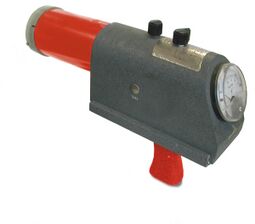Ion chamber EM spectrum scanner - 6665-001-013-0489
 | |
| Codification Data | |
|---|---|
| Supply Group | 66 – Instruments and Laboratory Equipment |
| Supply Class | 6665 – Hazard-Detecting Instruments and Apparatus |
| Codification Bureau | 001 – Earth |
| SIIN | 013-0489 |
| Item Data | |
| Item Name Code | 07833 – Radiacmeter |
| Below text | |
An ion chamber EM spectrum scanner is a hand-held piece of field-equipment, used to detect and analyze the presence of electromagnetic radiation. The design of this model scanner dates back the late 20th century and its only real change has been durability, range and the ability to do direct, in-field spectral analysis with its onboard computer.
The scanner comes standard with a 500 cc beta-gamma ion ionization chamber. One particularly unique feature of this instrument is the plug-in chamber design. Not only can different chambers be used with the instrument, the ion chamber can be separated from the unit and positioned up to 30 metres (98 ft) away via a cable. This allows the operator to easily observe the meter while remaining some distance from the radiation field being measured. This can be useful in situations where a local high radiation source needs to be monitored, while reducing the risk of exposure to the operator such as beta, gamma and x-ray monitoring. To make this possible, the electrometer tube is an integral part of the chamber assembly.
It has a large window covering the entire end of the chamber allowing measurement of betas down to 50 keV. A window shield is provided for allowing x-ray and gamma only monitoring. It has three ranges of 25, 250 and 2500 mR/h. It also has a battery check position on the switch.
The main unit consists of gray-painted cast bakelite housing, sitting on similarly made 'shoe' surmounting integral pistol grip. Inserted into front of housing is a safety orange cylindrical ionization chamber, 8 cm (3.1 in) diam., 21 cm (8.3 in) long, with window at front end covered by white plastic cap. The chamber has a standardized multi-pin base that plugs into the main unit. The plastic cap contains a calibration source. At the back of housing, facing operator, is 'rate' ammeter. The unit has two readily accessible controls: the six position function switch and the zero adjust. The bias and sensitivity controls are located behind snap plugs on either side of the case.
It has two chrome-plated 5 mm diam. wire retractable legs for self-standing applications. The legs may be rotated around their insertions in front and back of 'shoe' into retracted positions alongside housing, or can be removed entirely if not needed for sustained self-standing monitor situations, which is typical on away missions, or on standard ship-board duty.
This unit comes with a medium range, 2.5 R/h, and the high range, 250 R/h, ion chambers which are can be changed out in the field. It uses four 30, two 15, and four 1.3 volt batteries. The main unit is 8.9 cm (3.5 in) x 20.3 cm (8.0 in) x 31.75 cm (12.50 in) and weighs 1.82 kg (4.0 lb).
Ion chamber meters[edit | edit source]
This type of survey meter is any portable radiation detection instrument especially adapted for inspecting an area or individual to establish the existence and amount of radioactive material present. The survey meter typically measures the amount of radiation present and provides this information on a numerical display in units of counts per minute, counts per second, or microroentgen (µR) or microrem (µrem) per hour. The most commonly used hand-held survey meters are the scintillation counter, which is used in the measurement of alpha, beta and neutron particles; the Geiger counter, widely used for the measurement of alpha, beta and gamma levels; and the ion chamber such as this unit, which is used for beta, gamma and X-ray measurements.
The ionization chamber is the simplest of all gas-filled radiation detectors, and is widely used for the detection and measurement of certain types of ionizing radiation; X-rays, gamma rays and beta particles. Conventionally, the term "ionization chamber" is used exclusively to describe detectors such as this one which collect all the charges created by direct ionization within the gas through the application of an electric field. It only uses the discrete charges created by each interaction between the incident radiation and the gas, and does not involve the gas multiplication mechanisms used by other radiation instruments, such as the Geiger-Müller counter or the proportional counter.
Ion chambers have a good uniform response to radiation over a wide range of energies and are the preferred means of measuring high levels of gamma radiation. They are widely used in the nuclear power industry, research labs, radiography, radiobiology, and environmental monitoring.
Technical Characteristics[edit | edit source]
RADIACMETER
An item specifically designed to detect and measure radioactive energy; indicates directly. It may or may not include the function of a radiac computer.
| Code | Specification | Designation |
|---|---|---|
| ABHP | Overall length | |
| ABKW | Overall height | |
| ABMK | Overall width | |
| ADJH | Mounting method | Portable |
| AFJU | Carrying case | Not provided |
| AMKD | Indicator type | Meter |
| AMRM | radiation type and function | |
| AMRM | radiation type and function | |
| AMRM | radiation type and function | |
| AMRX | Detecting element type | Ion Chamber |
| APCB | Portability | Portable |
| APPK | Count range per minute | +0.0 to 110.0 |
| APPN | Accuracy in percent | -5.0 to 5.0 at Full Scale % at full scale |
| APPQ | Energy dependence rating | +50.000 to 1200.000 keV |
| FEAT | Special features | Interchangable Ion Chambers |